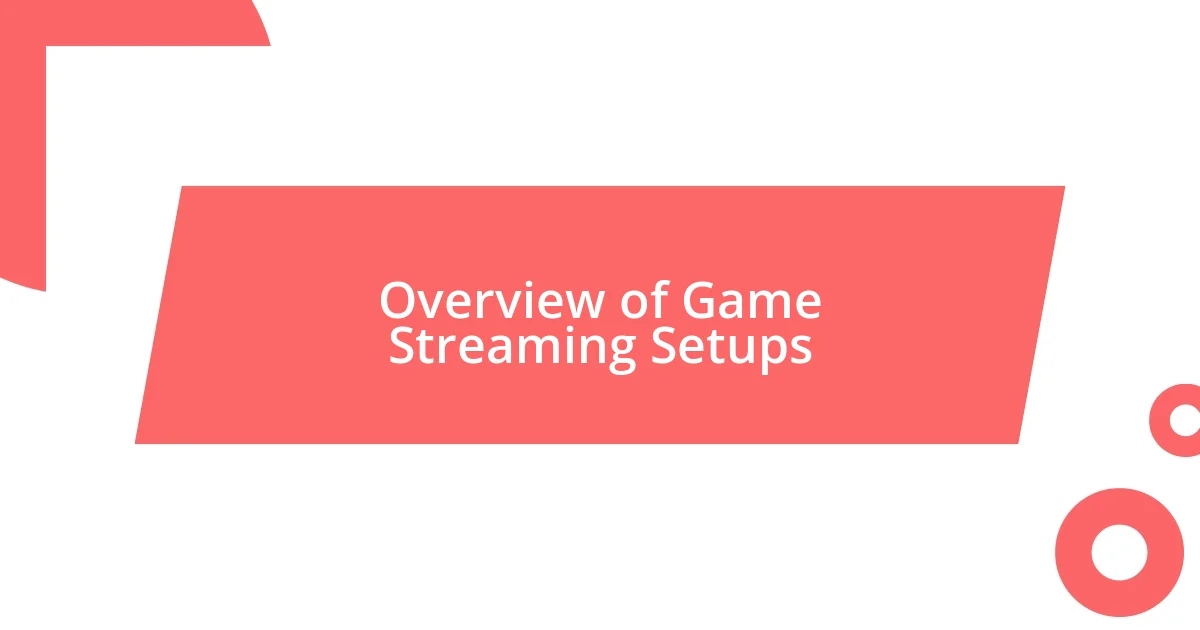Key takeaways:
- Investing in quality equipment like a microphone, webcam, and lighting significantly enhances audio-visual quality, improving viewer engagement.
- Choosing the right streaming software is crucial for a smooth experience, with options like Streamlabs OBS being beginner-friendly while OBS Studio offers customization.
- Engaging with your audience through real-time interaction and community-building activities fosters a stronger connection and enhances viewer retention.

Overview of Game Streaming Setups
When it comes to game streaming setups, having the right equipment can mean the difference between a lackluster stream and one that captivates your audience. I remember my first attempt at streaming; I was so excited but ended up with a fuzzy video quality that left viewers wondering if my gameplay was channeling a retro vibe. It’s crucial to focus on a clear camera, good lighting, and a reliable microphone to keep your viewers engaged right from the start.
The essentials of a successful streaming setup include a powerful gaming PC or console, high-speed internet, and a capture card, if you’re using a console. Have you ever been in the middle of an intense gaming session only to have your stream lag? I have, and it’s frustrating—not to mention, it can cost you viewers if they get discouraged. It’s important to ensure that your streaming infrastructure can handle the action you’re broadcasting without hiccups.
Additionally, software plays a vital role in how smoothly your stream runs and how you interact with your audience. I invested time in learning OBS (Open Broadcaster Software), and it opened up a world of possibilities for customizing my stream. I realized that the right overlays and alert systems can add a unique flair to my channel. Isn’t it fascinating how much you can enhance your viewer experience with just a few additions?

Essential Equipment for Streaming
Having the right equipment is crucial for anyone looking to make their mark in the streaming world. From personal experience, investing in a quality microphone transformed my streams. Initially, I used a basic headset, and while it worked, the sound quality was mediocre at best. Once I upgraded to a condenser microphone, I noticed a significant drop in background noise and an increase in clarity. My viewers even commented on how much more enjoyable it was to listen to me!
Another essential piece of equipment is the webcam. I remember when I first started, I relied on my laptop’s built-in camera, which was fine at the time. However, as my audience grew, I felt the urge to step up my game. Switching to a dedicated 1080p webcam made my visual presentation pop, and I could see the positive feedback from viewers almost instantly. High-definition video really does make a difference in viewer retention—people want to see you clearly as you share your gaming adventures.
Let’s not forget about lighting. I’ve experimented with different setups, and I can tell you that softbox lights or ring lights are key. Early on, I streamed with harsh overhead lighting, and it cast weird shadows on my face. Moving to soft, even lighting not only enhanced my appearance but also helped create a welcoming atmosphere. If you’re serious about streaming, take lighting into consideration; it can elevate your stream from average to professional status.
| Equipment | Purpose |
|---|---|
| Microphone | Enhances audio quality, ensures clear communication. |
| Webcam | Provides high-definition video, improves viewer connection. |
| Lighting | Creates a visually appealing stream environment. |

Optimal Streaming Software Choices
Choosing the right streaming software can truly shape your streaming experience, and I can’t stress this enough from my own journey. Early on, I experimented with a few different options, but finding the perfect fit took time. When I discovered Streamlabs OBS, everything changed for me. The user-friendly interface was a breath of fresh air, and the built-in features, like alerts and themes, made my streams much more engaging. I still remember the excitement I felt when I saw my first subscriber notification pop up live!
There are various streaming software options available, and each comes with its unique strengths. Here’s a quick comparison of popular choices I’ve found to be effective:
- OBS Studio: Free, open-source, and highly customizable, making it great for advanced users.
- Streamlabs OBS: More beginner-friendly, integrates handy features like chat overlays and donation alerts seamlessly.
- XSplit: Known for its ease of use, but has a subscription cost; often favored by professionals.
- NVIDIA ShadowPlay: Perfect for gamers with compatible graphics cards; captures high-quality gameplay without impacting performance.
Whichever software you choose, ensure it aligns with your streaming objectives. I’ve learned that investing time in mastering the software can yield quality results that keep viewers coming back. It’s about creating a suitable environment for your community, and the right software is pivotal in fostering that connection.

Setting Up Your Streaming Space
Creating a dedicated streaming space is vital, and I learned this through countless late nights adjusting my setup. I initially set up my gear in a shared room, and the distractions were endless. Once I carved out a specific area just for streaming, I noticed an immediate boost in my focus and energy. Isn’t it amazing how a little organization can transform your mindset?
When it comes to arrangement, I find that ergonomics plays a huge role. I’ve experimented with different desk heights and chair types, and I strongly advocate for investing in a comfortable chair. Believe me, a solid gaming chair not only supports long streaming sessions but also boosts your posture—who wants to deal with back pain mid-broadcast? Plus, it creates a professional look that enhances the overall aesthetic of your streaming space.
Lastly, consider the backdrop of your stream. In the beginning, I had a cluttered background, and it distracted viewers from the game. I’ve since curated my surroundings with personal touches like shelves of collectibles and some mood lighting. It’s a small change, but it gives my stream a unique personality. Think about what vibe you want to convey—do you want to be seen in a cozy den or a stylish studio?

Best Practices for Streaming Quality
When it comes to ensuring high streaming quality, a reliable internet connection is non-negotiable. I vividly recall a frustrating stream where I faced constant lag due to an unstable Wi-Fi network. Switching to a wired Ethernet connection was a game changer; my stream’s stability improved significantly, and I could finally focus on interacting with my viewers instead of worrying about disconnections. Have you ever been in a similar situation? Trust me, investing in a good router is worth it.
Another critical factor is your streaming bitrate. I used to think that higher was always better, but I learned the hard way that there’s a sweet spot depending on your upload speed and the platform you’re using. During one of my earlier streams, I set my bitrate too high, and it led to buffering issues that frustrated both my viewers and me. Striking the right balance—usually between 3,000 to 6,000 kbps for 1080p streams—will not only enhance viewer experience but also keep your stream running smoothly.
Don’t overlook the importance of proper audio quality, either. I can’t tell you how many times I tuned into a stream only to be greeted by muffled sound. When I upgraded to a good microphone, the difference was night and day. Viewers want to hear your commentary clearly, so investing in a quality mic can make your streams far more engaging. Have you thought about how audio impacts your overall broadcast experience? It’s often an underappreciated element, but it can truly make or break the connection you form with your audience.

Engaging with Your Audience
Engaging with your audience is one of the most rewarding aspects of streaming. I vividly remember a gaming session where I decided to involve my viewers by asking for suggestions on what game to play next. The chat erupted with enthusiasm, and it felt like we were embarking on an adventure together. Have you ever experienced that electric connection? It’s a reminder of how powerful real-time interaction can be in creating a community.
In my early days, I often streamed without acknowledging my chat. Initially, I was focused solely on the gameplay, but I quickly learned that responding to viewers’ comments turns a broadcast into a shared experience. There’s something special about taking a moment to read and reply to messages—it’s like a high-five across the screen! I noticed that my viewer retention increased once I became more interactive. The chat became lively, and participation soared. Have you thought about how a simple acknowledgment can transform your streaming atmosphere?
Building a sense of community is essential. I found that creating a themed night, like “Flashback Fridays,” where I revisit classic games and chat about my nostalgic memories, invited viewers to share their own stories. This not only sparks engagement but helps foster connections. A good community thrives on shared experiences. How can you create such moments in your streams? It’s all about crafting an inclusive environment where everyone feels like they belong.















